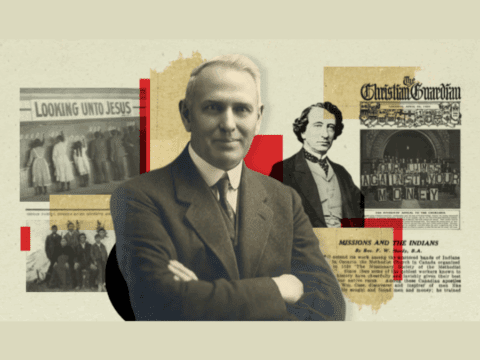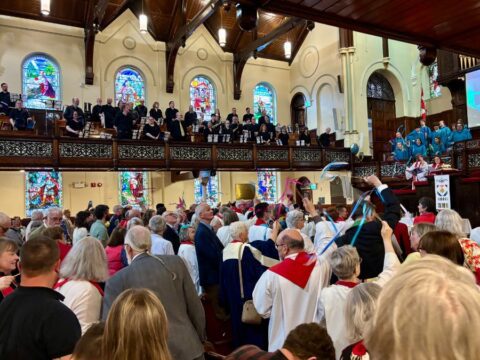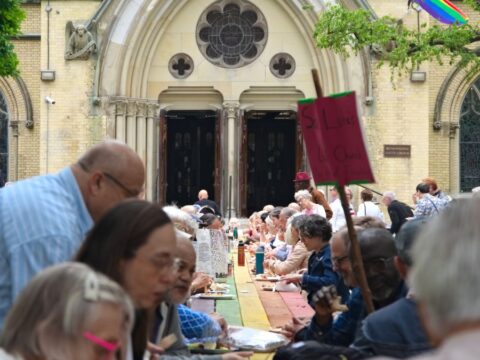Goodbye Conferences and Presbyteries; hello Regions. Volunteers and staff across the denomination have spent years preparing for this month’s transition to the United Church’s new governance model. But even as the changes come into effect, there is still work to be done and lots of open questions.
THE BASICS
The broad strokes of the new structure are clear: Presbyteries and Conferences are replaced by Regions, and an Office of Vocation has taken over accreditation, oversight and discipline of ministers. A denominational council, still called General Council, and local pastoral charges, now communities of faith, retain most of their old functions.
The boundaries of the 16 new Regions are finalized, and six former Conference executive secretaries were chosen to become executive ministers. They’ll help regional transition commissions carry out the change, and along with staff program assistants, will oversee the work of two or three Regions.
The original re-organization goal was to create a more affordable church structure — helping General Council get perennial deficits under control — while giving individual congregations more autonomy. The jury’s still out on whether communities of faith will have more freedom to decide on their own personnel and property matters, but General Council plans to balance this year’s budget, and Regions seem ready to keep costs in line.
MONEY
The church has entirely changed the way it handles money. In the old model, individual pastoral charges paid assessments, kind of like taxes, to their Conference or Presbytery. The governance and administration work done by General Council, as well as grants to Conferences, came from voluntary donations to Mission & Service — made by only about half of pastoral charges. It was complicated.
Now, communities of faith send tax-like money directly to General Council, which uses it to pay its governance costs and distributes the rest equally among the Regions to pay for their own. One hundred percent of money donated to Mission & Service now goes exclusively to mission work — meaning that on the whole, the church should be able to spend more on mission and ministry.
This equal sharing of total assessment money means that parts of the church that used to scramble to meet their financial needs (like Region 6, an enlarged version of Manitou Conference) are more comfortable. But areas like Region 1 (former B.C. Conference), where former Conferences collected more from their own assessments, are being forced to cut costs. (Though assessments aren’t Regions’ only form of income. They may also have their own investment or bequest income, passed on from Conferences or Presbyteries.) They have the option to collect additional money directly from their own communities of faith, but are trying to avoid that.
At the local level, one of the most contentious issues in the restructuring project was the amount of money each congregation sends to General Council. These assessments are now set at 4.5 percent of a community of faith’s total revenue, not including things like funds for Mission & Service and refugees, bequests and property sales. For some congregations, this is great: they’ll be paying less than they had to send to their Conference and Presbytery in the old model. Others will end up owing more. To ease the burden, these communities of faith can increase their old amount by 10 percent each year for the next three years.
This financial overhaul “to some extent may be the easiest part” of the transition to the new church model, says Erik Mathiesen, General Council’s chief financial officer. The formula for determining the amount of each assessment is clear, and by late October, pastoral charge treasurers had online access to the preliminary amount they owe, to let them set 2019 budgets.
The new funding model will affect the roles of each part of the church, says Rev. Doug Goodwin, longtime executive secretary of B.C. Conference and current executive minister for Regions 1 and 3. “Having numerous Regions with, generally, less money and less ability to function well will mean the diminishment of the middle court and the work that has been done at that level,” he says. “The communities of faith will, by necessity, become more congregationalist, although without any additional power or authority to really be independent.” Whether either of those outcomes is a good or bad thing, he adds, will be seen later.
MINISTRY AND STAFF
The funding decision may have been the most controversial, but the new middle council and new administration of ministry personnel bring about more complex changes and may have longer-term effects on communities of faith. After all, having qualified, competent ministers and maintaining ongoing good relations with them is crucial.
Previously, Presbyteries handled everything related to ministers, with some help from Conferences (though a few recent pilots put Conferences in charge instead). In the new structure, the Office of Vocation — based in General Council but with additional regional staff — is in charge of ministry candidacy, standards and discipline. Regions are overseeing the hiring, handling and care of individual ministers, and supporting the volunteer ministry and personnel committees that are on the front lines in local communities of faith.
The Office of Vocation’s staff, volunteer board and six candidacy commissions are already in place. The 16 Regions have all hired staff for pastoral relations work, and some have also hired people to work on mission and programs. Most regional staff members previously worked for a Conference or Presbytery. That cut severance costs and meant there were very few open job searches for new staff. Having experienced staff is a plus, says Rev. Faith March-MacCuish, executive minister for the church’s three easternmost Regions. “They know the territory,” she says. “They know the people, and in some ways their work can be more focused.”
Along with keeping pastoral relations running smoothly, Regions are tasked with “encouraging and supporting ministry personnel towards health, joy and excellence in ministry practice.” Regional volunteers and staff will have to figure out exactly what that means — and how to do it. Until it’s all sorted out, many existing Presbytery pastoral relations committees have been asked to remain on call.
THE DETAILS
Regions have until June 30 to choose their names. At press time, eight had done so, including Pacific Mountain (Region 1), which is largely in British Columbia, Chinook Winds (Region 3) in southern Alberta, and Eastern Ontario Outaouais (Region 12). Some are holding contests to decide.
Most Regions plan to hold inaugural annual meetings between April and June. By then, the regional commissions should have decided whether their Region needs a president (it’s not mandatory).
The new 18-member Executive of the General Council (down from 50) gathered for orientation sessions last fall. Regions have no official Executive representatives — there just aren’t enough seats. Still, the new Executive’s diversity “is quite something to observe,” says Rev. Teresa Burnett-Cole of Glebe-St. James United in Ottawa, who represents the Indigenous church in the group. “Those voices that have often been submerged are right at the table.”
By now, Presbyteries and Conferences should have finished transferring all funds, investments and assets to the appropriate regional council. “We’ve asked the Presbyteries and Conferences to do as much housecleaning as possible,” says Rev. David Allen, remit implementation project leader. Everything from mail and minutes, to video licences, sacramental licences, policies, forms, resources, employee contracts, and lists of Licensed Lay Worship Leaders and Affirming Ministries have gone to Regions. Lists of conflict resolution facilitators, interim ministers and educational supervisors have gone to the Office of Vocation.
Along the way, though, the regional commissions don’t want to lose track of volunteers who have been active in Conferences and Presbyteries. To start, each Region will need up to 25 volunteers to act as regional liaisons, mainly to accompany communities of faith through ministry candidacy and pastoral relations processes.
“The communities of faith will, by necessity, become more congregationalist, although without any additional power or authority to really be independent.”
WHAT STILL NEEDS TO HAPPEN?
Toward the end of last year, much work remained, including the creation of clusters and networks. Clusters are places where communities of faith and their leaders can gather, perhaps replacing the collegial function of Presbyteries, while networks are envisioned as groups addressing social justice, intercultural issues or other specific topics.
Some existing groups, such as the Social Justice Network of Ontario Conferences (SJNOC), met last fall to figure out how to continue their work in the new church structure. “The big issues for me are accountability for networks and having the resources for them to do their work,” says Rev. Susan Eagle of Grace United in Barrie, Ont., a longtime SJNOC member and church social activist. With Conferences and Presbyteries morphing into Regions, she is concerned that volunteer committees on issues like social justice will be lost.
As for the Indigenous church, it is working on forging a new relationship with the wider United Church, but will do so in its own way and at its own pace, as requested by the Calls to the Church document adopted at General Council. So far, Indigenous communities of faith have given up their own Conference and Presbyteries and have opened the door to dual belonging in both the newly named National Indigenous Council and in the Regions. Indigenous people also have distinct representation in the Office of Vocation.
The Indigenous council has been holding implementation gatherings from Ontario to British Columbia since last November. These gatherings are connecting Indigenous communities of faith with Regions, and they will continue until next month. The Indigenous church’s processes may be slower, but “these are really important decisions to make,” says Rev. Maggie Dieter, the National Indigenous Council’s executive minister. “There are important relationships to develop, and that can’t be done overnight.”
Some folks in the wider church are thinking the same thing and feel the launch of the new church structure this month may have been rushed. “I think we just went a bit too quickly in choosing an artificial date,” says Rev. Kevin Dingwell, minister at the Mount Stewart-Morell-St. Peter’s Bay (P.E.I.) charge and a commissioner for Region 14. He’s wary of “major disagreements” that might arise, but hopeful that good intentions will help smooth them out. “The dedication is still there, and I hope that dedication will be the light that guides us.”
This story first appeared in The United Church Observer’s January 2019 issue with the title “A time of change.”














